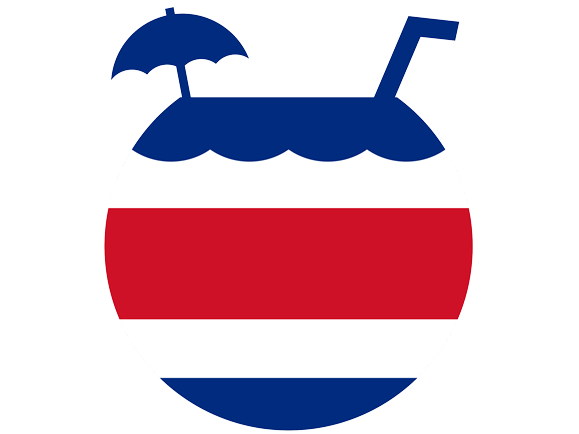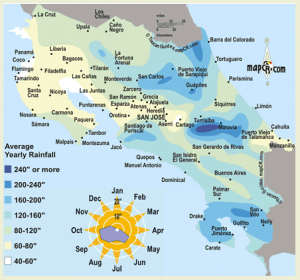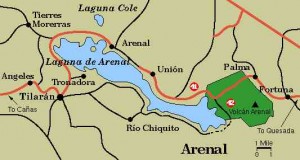Life in CR
Monthly Costa Rica Weather Report for 8 Towns in Costa Rica–October 2015
- By in Blog
![]()
You’ll notice that we now show rainfall and temperatures for eight towns in Costa Rica:
- San Ramón de Alajuela
- Atenas
- Nuevo Arenal
- Quepos
- Near San Isidro de General
- San Rafael de Heredia
- San Marcos de Tarrazu
- El Cajón de Grecia
This isn’t weather forecasting. We report after the fact to give you a much better picture of the weather in each of these areas.
You can click on the map above to enlarge it and check out the average rainfall for the towns in which you are interested.
Paul’s San Ramón Observations, Facts, & Tidbits for October:
- We got over 28 inches of rain this October, in our mini-microclimate located 10 minutes from San Ramon, and 25 inches in September.
- The rainy season for the Central Valley normally ends in mid-November, with September and October being the rainiest months.
- It rains less in the town of San Ramon than in the mountains surrounding it, and the highs are generally warmer. On October 15th, we had 6.875 inches of rain, making it the rainiest day of the year. And between the 12th and the 17th (6 days), we had a total of 19 inches!
- We live at 3000 ft. but it’s a cool 3000 ft. as you can see from our temperature comparisons with other locales at higher altitudes. Just goes to show you that the micro-climates are a function of not just altitude but topography also.
- On October 31st, Sunrise was at 5:29am and sunset was at 5:16pm.

- Our GPS readings: N 10° 3′ 58″ and E 84° 29′ 3″
- Total rainfall in 2014 total was 120 inches and 2013’s rainfall was 111 inches in our area of San Ramón.
Lance T’s Atenas Observations, Facts, & Tidbits for October:
- During October, we had a lesson in just how significant the micro-climates in Costa Rica can be. For 8 days, we lived in a house just 4 miles as the crow flies from our normal house, but at an elevation about 445 feet lower. Daytime highs at our temporary abode ranged between 89.4 and 94.4 °F. On 2 days, the “feels like” temperature exceeded 100 °F. In contrast, the “feels like” highs where we normally live were typically about 6 to 10 degrees cooler.
- Rainfall was normal, although a bit less than last year.
- Lesson: If you choose to spend any significant amount of time living in Costa Rica, then take care to select a place which has an elevation consistent with your temperature comfort zone.
- Total rainfall in 2014 was 73.59 inches and 2013’s rainfall was 63.84 inches in our area of Atenas.
John’s Nuevo Arenal Observations, Facts, & Tidbits for October:
- We continued on our record-setting pace for annual rainfall, even though this month had less rain than previous Octobers.
- On the 29th of October, we acquired a nine month old Great Dane puppy that we named Mancuso, after a television series that we watched 20 years ago.
- We had a record-breaking 185 inches of rain for the year 2014. Total rainfall in 2013 was 164.75 inches in our area of Nuevo Arenal.
Lance M’s Central Pacific Observations, Facts, & Tidbits for October:
- Temperatures have been cooler this last month during the day, but the Costa Rican people are saying that this dry season is going to be hotter and dryer than usual. Their major concern is for the ocean temperatures that are usually in the low 80’s. If the temperatures rise to the upper 80’s or low 90’s, the fish will move out to deeper water, causing the fish prices to rise significantly throughout the world. This area is one of the largest producers of fish that is shipped all over the world. Hopefully the locals are wrong but most of their predictions have come true in the past.
- October was a month that found a rash of robberies occurring as the rainy season is coming to an end.
- We continue to receive e-mail from folks that read the article in International Living on the Southern Zone.
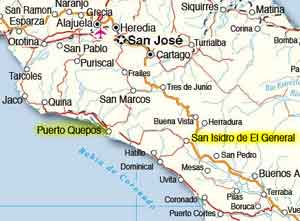 2014 rainfall for the Quepos area of the Central Pacific was 73.54 inches (as of February 2014 when I started measuring it for this newsletter).
2014 rainfall for the Quepos area of the Central Pacific was 73.54 inches (as of February 2014 when I started measuring it for this newsletter).
Gordon’s Quebradas (San Isidro de General) Observations, Facts, & Tidbits for October:
- We are still gone on vacation for 2 months in Canada; 1 month in Alberta, where we moved from, and 1 month in Newfoundland, which is home for my wife. When we return, we will be living in a new area — Abarrio — which is located about 3 km. NW of San Isidro de El General, at an altitude of about 800 meters, which is 200 meters lower than where we now are. Friends of ours are building a new house on their property and will be renting it to us. Life is good. Pura Vida!
Steve’s San Rafael de Heredia Observations, Facts, & Tidbits for October:
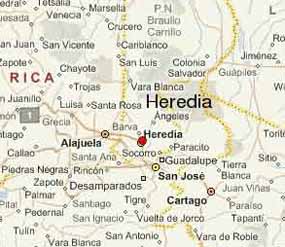 Rainy Season and El Niño ? Total rainfall to date is 123.9 inches. Last year at this time it was 101 inches. We expect it to drop off dramatically in November. Even so, after five full years of recording rain data, this is already the second rainiest year. Rainfall for October was about 30% above normal and it was the second rainiest month in the 64 months that I’ve collected data. That said, October was a delightful month for us. I think the difference was the fact that we have had no temporales (long rainy spells). Mornings have been sunny and afternoons rainy. As for warmer temperatures, I’ve seen reports in the news that temperatures are four degrees Celsius (this would be seven degrees Fahrenheit) above normal. Four degrees Celsius is an astronomically increase. I’m skeptical. The data I’ve collected does not show any increase in temperature. It will be interesting to read the reports from the other weathermen of Retire for Less in Costa Rica.
Rainy Season and El Niño ? Total rainfall to date is 123.9 inches. Last year at this time it was 101 inches. We expect it to drop off dramatically in November. Even so, after five full years of recording rain data, this is already the second rainiest year. Rainfall for October was about 30% above normal and it was the second rainiest month in the 64 months that I’ve collected data. That said, October was a delightful month for us. I think the difference was the fact that we have had no temporales (long rainy spells). Mornings have been sunny and afternoons rainy. As for warmer temperatures, I’ve seen reports in the news that temperatures are four degrees Celsius (this would be seven degrees Fahrenheit) above normal. Four degrees Celsius is an astronomically increase. I’m skeptical. The data I’ve collected does not show any increase in temperature. It will be interesting to read the reports from the other weathermen of Retire for Less in Costa Rica.- Gardening – Asparagus harvests have been excellent due to high rainfall combined with heavy applications of manure and compost spread on top of the asparagus beds. Beet, culantro, onion, leek, carrot, pepper, cucumber, radish, uchuba, blackberry, and raspberry harvests have been good also. The strawberries are hoping for dryer weather. We got our first guava (guayaba) harvest this year. There is a lot of coffee grown in our area and the harvest is beginning unusually late (perhaps because August was so dry). Migrant Nicaraguans began arriving about a week ago to pick coffee and there is very little work for them.
- Another Little Vacation – This month we visited Rio Perlas Hotel in Orosi de Cartago. We were a little worried because we’d read some bad reviews in TripAdvisor. We thought it was delightful and intend go back soon. We loved their hot springs.
Bonnie’s San Marcos de Tarrazu Observations, Facts, & Tidbits for October:
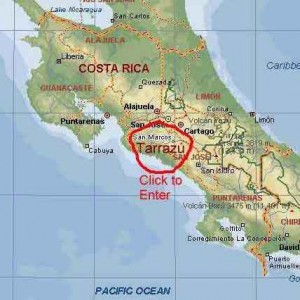 We were travelling the first three days of October, so our temperature data is based on 28 days. Our neighbor tracked the rainfall for us, so those numbers reflect the entire month.
We were travelling the first three days of October, so our temperature data is based on 28 days. Our neighbor tracked the rainfall for us, so those numbers reflect the entire month.- Temperatures here continue to average in the low 60’s at night and in the low 80’s during the day, with rainfall about the same in October as it was in September.
- Year to date rainfall total is for August, September, and October.
Irina’s El Cajón de Grecia Observations, Facts, & Tidbits for October:
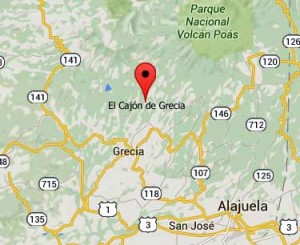 October rainfall measured 25.5″ / 647.6 mm (compared to 42.0″ / 1066.0 mm in 2013, and 23.8″ / 605.5 mm in 2014).
October rainfall measured 25.5″ / 647.6 mm (compared to 42.0″ / 1066.0 mm in 2013, and 23.8″ / 605.5 mm in 2014).- It wasn’t nearly as wet as it should have been, with October supposedly being the wettest month. But as we know now (mid-November), November is far wetter than a normal October.
- October was nevertheless very moist and thus slippery and it became necessary to lyme the sidewalks and access roads in and to our property, lest anyone would fall and injure him/herself.
- October was also “the last chance” to transplant trees and shrubs to avoid watering them once the dry season starts.
Costa Rica Weather Report for October
Meteorology has been Paul’s lifelong hobby. As a child, he devoured books about the weather and earth sciences vigorously. Later, he took a few college courses in meteorology, and still later, he served as a meteorologist for the U.S. Army in Vietnam. Now, Paul gets to practice his avocation in Costa Rica, albeit on a very small scale with just temperature and rainfall data, probably the two most important factors regarding the weather. He wanted to include weather info on our website to help people decide where to live, although weather is just one of many factors to consider in determining where to relocate. Current weather data is from our current home at about 3,000 ft. elevation and 10 minutes outside the town of San Ramón. Weather data prior to December 2012 is from our previous home at about 4,000 ft. elevation and 10 minutes outside the town of San Ramón.

Our Atenas Weatherguy, Lance Turlock
Lance and his wife, Diana, moved to Costa Rica about 2 years ago after living 30+ years in the Lower Mainland of British Columbia (Vancouver and environs). They live in the Central Valley near the town of Atenas and are at an elevation of about 2700 feet. They have no need for air conditioning or heating. Overnight low temperatures are comfortably cool (low 60’s). Daytime highs can be relatively hot (high 80’s, low 90’s), but rarely uncomfortably hot.Lance started to keep track of daily temperatures and rainfall in order to have factual ammunition to help disabuse friends, relatives and acquaintances of any misconception that the weather must be like that of a tropical jungle.
Our Nuevo Arenal Weatherguy, John Nicholas
After many visits to Costa Rica, John and Cathy Nicholas moved from New York to Costa Rica in 1991. They chose Arenal for its sacred, majestic beauty, its lush wildlife, its relaxing lifestyle, and its proximity to activities and sites such as the Volcano Arenal and the beaches. They own the B&B, Chalet Nicholas, which has been in operation since 1992. Temperatures and rainfall are measured at Chalet Nicholas which is located at approximately 2,200 ft. elevation and 1 mile west of the town of Nuevo Arenal.
Our Central Pacific (Quepos) Weatherguy, Lance Miller
 I was born in a very small town in northwest Iowa and raised on a farm. When I was 18, I joined the service, in which I spent 22 years before retiring in 1990. For the next twenty three years my family and I lived in south central Pennsylvania. After having a stroke in 2012, I was unable to work and that is when my wife and I began talking about retiring. Thanks to your newsletter and a website we found about San Isidro, we began looking at Costa Rica. We came down in March 2013 and looked around for a week. Went home, packed up, and moved here in April. We settled in a small village called Playa Matapalo which is located between Quepos and Dominical. We later moved to Quepos. The word Playa means beach. It is so nice to lie in bed and listen to the ocean. Pura Vida.
I was born in a very small town in northwest Iowa and raised on a farm. When I was 18, I joined the service, in which I spent 22 years before retiring in 1990. For the next twenty three years my family and I lived in south central Pennsylvania. After having a stroke in 2012, I was unable to work and that is when my wife and I began talking about retiring. Thanks to your newsletter and a website we found about San Isidro, we began looking at Costa Rica. We came down in March 2013 and looked around for a week. Went home, packed up, and moved here in April. We settled in a small village called Playa Matapalo which is located between Quepos and Dominical. We later moved to Quepos. The word Playa means beach. It is so nice to lie in bed and listen to the ocean. Pura Vida.
 Our Quebradas (15 minutes north of San Isidro de General) Weatherguy, Gordon Stanley
Our Quebradas (15 minutes north of San Isidro de General) Weatherguy, Gordon Stanley
Gordon and his wife Bea moved here from Lloydminster, Alberta, Canada, where he used to track the correlation of the winter hoer frost and the spring/summer rains. After 30+ years as a Purchasing Agent for a retail lumber yard/Homes Manufacturing company, he decided to say “Adios” to the snow and ice. They arrived in Costa Rica Oct. 3, 2014, and live in Quebradas, which is a 15 minute drive North of San Isidro de General, at an elevation of about 3600 feet. There is a stream that runs behind the hill in their back yard, so are “forced” to listen to the sound of running water 24/7. Ahh the tough life! They are totally enjoying their new found retirement freedom in this wonderful land that they discovered thanks to this newsletter.
 Our San Rafael de Heredia Weatherguy, Steve Johnson
Our San Rafael de Heredia Weatherguy, Steve Johnson
I’m a weather geek and have been recording daily weather data for the last 4 years in Concepcion de San Rafael de Heredia. We live at 5,000 ft. (1,500 meters) elevation, above San Rafael centro on a low ridge that comes off of Cerro Chompipe (between Barva Volcano and los Cerros de Zurqui). We have a 60 mile wide view from Turrialba Volcano east to somewhere around Cerro Turrubares west. I first lived in CR as a Peace Corps volunteer (1968-71), married a tica school teacher, and moved back to Costa Rica in 2009. My wife grew up in downtown San Rafael just three miles away, and the weather is quite different there. I am also an avid gardener and birder.
 Our San Marcos de Tarrazu Weathergirl, Bonnie Vining
Our San Marcos de Tarrazu Weathergirl, Bonnie Vining
Bonnie, her husband Joe, and their dog Marley moved from Tucson, Arizona, to San Marcos de Tarrazu, in mid-2015. Bonnie was a CPA, turned software engineer with IBM for 20 years and later opened and operated a specialty coffee shop, founded a non-profit dedicated to connecting musicians with appreciative audiences, and managed a school district theatre. A self-professed “data geek”, she looks forward to being our weathergirl while pursuing her other passions which include traveling, gardening, cooking, hiking, meeting people, and hanging out with Joe and Marley. They are enjoying retirement life in the town of San Marcos which lies at about 4,800 ft. in the heart of Costa Rica’s prime coffee-growing region.
Our El Cajón de Grecia Weathergirl, Irina Just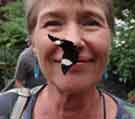
Born in Germany, Irina spent 40+ years in the USA (all on the Pacific coast) before she and her husband Jim moved to Costa Rica three years ago. For the 20 years prior, they owned and operated a vineyard in the Willamette Valley of Oregon, famous for award-winning pinot noir. During that time, it became critical to keep precise records of daily temperatures, rainfall and pertinent weather patterns to accurately forecast seasonal tasks, such as when to prune the grapes, when to harvest, when to protect them from an early or late frost. As little as one degree made the difference between a bountiful harvest – or a lost crop. After moving to el Cajón de Grecia, the Justs continued to take daily readings of temperatures and measurements of rainfall because they quickly discovered that the micro-climate in the foothills of Poás differs widely from the weather in nearby Grecia.
Related Articles:
- For a “Just the Facts” Version of our 2015 Weather: Costa Rica Weather: 2015 Monthly Temps & Rainfall
- Our Weather in San Ramón & Atenas Costa Rica – 2014
- Our Weather in San Ramón & Atenas Costa Rica – 2013
- Our Weather in San Ramón de Alajuela, Costa Rica – 2012
- Our Weather in San Ramón de Alajuela, Costa Rica – 2011
- 15 Days
- El Nino – What is it?
